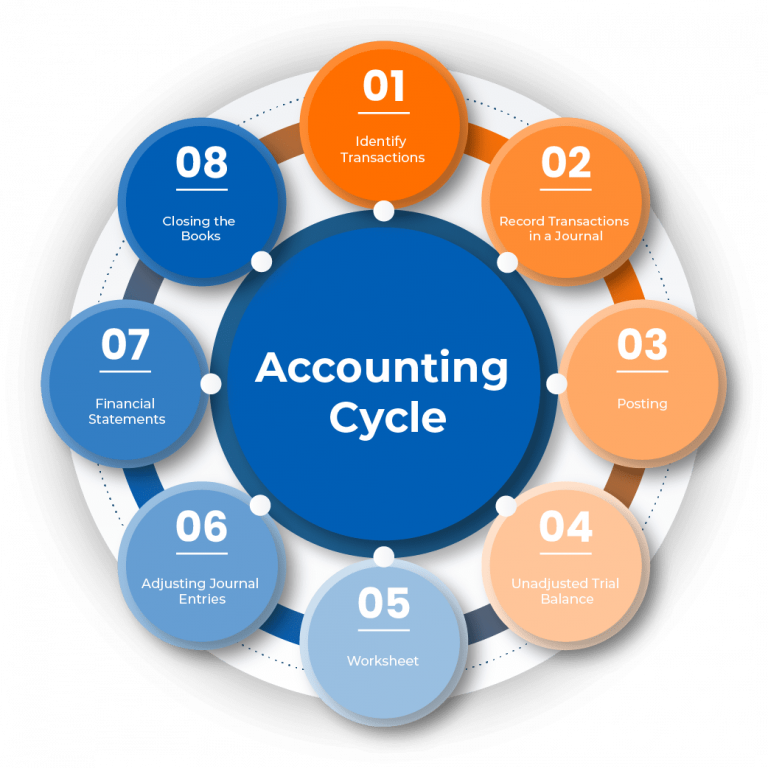The 8 Steps Of The Accounting Cycle

There are eight accounting cycle steps that every small business owner can follow to ensure proper bookkeeping. While accounting software and technology programs certainly help automate many of these steps, having a solid understanding of the accounting cycle is important – especially for small businesses with minimal technical support.
The steps of the accounting cycle provide a clear guide for recording, analyzing, and reporting a company’s financial activities. With the right knowledge and tools at your disposal, you can confidently manage your finances and take your business to the next level.
What Is The Accounting Cycle?
This process is a series of steps that businesses follow to record and track their finances, from the initial transaction all the way through to the final reporting stage.
Every individual company will need to modify the eight step accounting cycle to fit its business model and accounting procedures, including the choice between accrual and cash accounting and single-entry versus double-entry accounting (but let’s not get too technical right now)
Step 1: Identify Transactions
The first step in the accounting cycle is to identify all the transactions that occur in your business during the reporting period. This includes sales, purchases, expenses, and any other financial transactions that occur.
Every transaction must be properly recorded on your company’s books to ensure accurate financial statements. It’s important to keep proper records of transactions as this information will be used to create financial reports at the end of the cycle.
Step 2: Record Transactions In A Journal
Once transactions have been identified, they need to be recorded in a journal. A journal is a record of all financial transactions, including the date of the transaction, the accounts affected, and the amounts involved.
This step in the accounting cycle is important as it ensures that all transactions are recorded in the correct accounts and with the correct amounts. This will make sure that your financial statements accurately reflect the financial position of the business.
Step 3: Posting
After transactions have been recorded in the journal, it’s time to move them over to the general ledger. This is where all the financial transactions for your business are recorded and organized by account. By grouping transactions in this way, you’ll be able to get a clearer picture of your financial position and monitor your business’s status more easily.
Step 4: Unadjusted Trial Balance
As the accounting period comes to a close, it’s time to take a closer look at your finances and ensure that everything is in order. That’s where the unadjusted trial balance is useful. This helpful step in the accounting cycle calculates the total credit and debit balances, giving you a clear picture of your company’s unadjusted balances in each account.
By comparing these balances, you can ensure that your financial records are accurate and up-to-date, and take the necessary steps to address any discrepancies.
Step 5: Worksheet
The fifth step in the accounting cycle involves analyzing your worksheet and identifying any necessary adjusting entries. This process is crucial for ensuring that your debits and credits are equal and that your financial records are accurate. By creating and using a worksheet, you can easily identify any discrepancies and make the necessary adjustments to get your finances back on track.
Step 6: Adjusting Journal Entries
In the sixth step, a bookkeeper makes adjustments. Journal entries are used where adjustments are necessary. Adjusting entries are made to ensure that the financial statements accurately reflect the financial position of the business at that point in time. These adjustments are made to account for items such as depreciation, bad debts, and other items that were not recorded in the initial journal entries.
For example, often your business may have issued an invoice but not received the income in the same period. That income needs to be reported in the period in which the invoice went out, meaning that an adjusted journal entry needs to be made.
Step 7: Financial Statements
Once all the necessary adjusting entries have been made, it’s time to generate your financial statements in the seventh step of the accounting cycle. These statements provide a comprehensive overview of your business’s financial position, including important details like revenues, expenses, assets, and liabilities. And they’re not just for internal use – investors, lenders, and other stakeholders will use these statements to evaluate your company’s financial health and make important decisions.
Step 8: Closing The Books
Congratulations, you’ve made it to the final step of the accounting cycle! In the eighth step, it’s time to close your books and prepare for a new reporting period. By doing so, you’ll be able to analyze your company’s performance over the previous period.
At this point it’s a good idea to meet with your accountant and get their insights into your business. A good accountant should be able to go through your records and identify areas to cut expenses, save tax, and boost profitability.
What Is The Purpose Of The Accounting Cycle?

By following this eight-step process, small business owners can maintain accurate and efficient financial performance analysis, making it easier to make informed decisions and plan for the future.
Accounting Cycle vs Budget Cycle
What’s the difference between the accounting cycle and the budget cycle?
While the accounting cycle looks at past financial transactions and creates reports, the budget cycle is an estimation of revenue and expenses over a specified period looking forward. It’s used to forecast revenues and expenses in the future. It also looks at future financial projections and is a useful resource for creating plans.
Can I Outsource the Accounting Cycle Steps?
Outsourcing your accounting functions offers several benefits, including cost savings, improved accuracy, and access to specialized expertise.
As a busy entrepreneur, you’re always looking for ways to streamline your business and make your life easier. Accountex can take care of all of your accounting needs and provide you with the advice to run a better business. Reach out to the team today.
